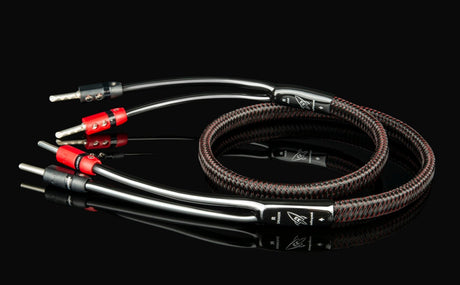
AudioQuest at AXPONA 2025
AudioQuest is gearing up for AXPONA 2025 where we'll be contributing power and cables to no fewer than 10 systems throughout the show.
Câble d'interconnexion audio
Souvent, le choix entre terminer vos câbles d'enceinte avec des fourches ou des fiches bananes dépendra de la préférence personnelle. Cependant, les bornes de liaison isolées conformes à l'UE utilisées sur certains amplificateurs de puissance rendent souvent difficile, voire impossible, de serrer les fourches avec un couple ou une pression élevés. Dans ces applications, le connecteur banane AudioQuest est le meilleur choix, et peut être le seul.
AudioQuest a mené une enquête assez exhaustive auprès des fabricants d'amplificateurs contemporains pour déterminer si les fourches ou les bananes seront les plus appropriées pour une marque et un modèle d'amplificateur donnés. Veuillez nous contacter, fournir la marque et le modèle de l'amplificateur, et nous vous répondrons quel type de connecteur est optimal.
Ici, nous recommandons généralement le connecteur U-Spade ou banane. Cependant, même s'il y a moins de poids et de pression de ce côté du câble (particulièrement pour les ensembles Bi-Câblage), il est néanmoins important de noter la conception du bornier. Si un connecteur banane ne peut pas s'insérer complètement dans la bornier, nous recommandons l'un de nos connecteurs à fourche.
Conducteurs en cuivre à surface parfaite solide+ (PSC+)
Les conducteurs solides empêchent l'interaction électrique et magnétique des brins. Le cuivre solide PSC+ minimise la distorsion causée par les frontières de grains et maximise la dissipation linéaire du bruit RF.
Réduction du bruit à 3 couches basée sur Carbon
Il est facile de réaliser une couverture de blindage à 100 %. Empêcher les interférences de radiofréquences captées (RFI) de moduler la référence de masse de l'équipement nécessite le Noise-Dissipation System (NDS) de AQ. Les systèmes de blindage traditionnels absorbent généralement et drainent ensuite l'énergie de bruit/RF vers la masse du composant, modulant et déformant le plan de masse « de référence » critique, ce qui entraîne à son tour une distorsion du signal. Les couches alternées de métal et de matériaux synthétiques chargés de carbon de NDS « protègent le blindage », absorbant et réfléchissant la plupart de cette énergie de bruit/RF avant qu'elle n'atteigne la couche attachée à la masse.
Conducteurs à direction contrôlée
Tous les brins ou conducteurs métalliques étirés ont une structure de grains non symétrique, et donc directionnelle. AudioQuest contrôle la variation d'impédance RF résultante afin que le bruit soit drainé loin de là où il causerait de la distorsion. La direction correcte est déterminée en écoutant chaque lot de conducteurs métalliques utilisés dans chaque câble audio AudioQuest. Lorsque cela est applicable, des flèches sont clairement marquées sur les connecteurs pour garantir une qualité sonore supérieure. Pour la plupart des modèles de câbles AQ, les flèches indiquent non seulement la direction qui optimise la directionnalité du métal dans le cadre de la dissipation du bruit, mais indiquent également l'attachement non symétrique du blindage et de la masse pour optimiser la performance du système complet. Un aspect fondamental de la technologie de dissipation du bruit multifacette de AudioQuest, les conducteurs à direction contrôlée garantissent que le bruit induit est dissipé et drainé correctement.
Géométrie triple équilibrée
Notre géométrie triple équilibrée utilise un conducteur de référence de masse séparé, de sorte que le blindage du câble n'est jamais utilisé comme un conducteur inférieur. Qu'ils soient préparés avec des fiches RCA ou XLR, les trois conducteurs du câble garantissent que les signaux positifs et négatifs ont des chemins de conduction également supérieurs et à faible distorsion.
Isolation en mousse à cellules dures
L'isolation en mousse à cellules dures (HCF) assure une géométrie critique des paires de signaux. Tout matériau solide adjacent à un conducteur fait en réalité partie d'un circuit imparfait. L'isolation des fils et les matériaux des circuits imprimés absorbent tous l'énergie. Une partie de cette énergie est stockée puis libérée sous forme de distorsion. L'isolation en mousse à cellules dures est similaire au PE moussé utilisé dans nos câbles Bridges & Falls plus abordables, et est injectée d'azote pour créer des poches d'air. Parce que l'azote (comme l'air) n'absorbe pas l'énergie et donc ne libère pas d'énergie depuis ou vers le conducteur, la distorsion est réduite. De plus, la rigidité du matériau permet aux conducteurs du câble de maintenir une relation stable tout au long de la longueur du câble, produisant un caractère d'impédance stable et minimisant davantage la distorsion.
Terminaisons en argent suspendu soudé à froid directement sur cuivre violet pur